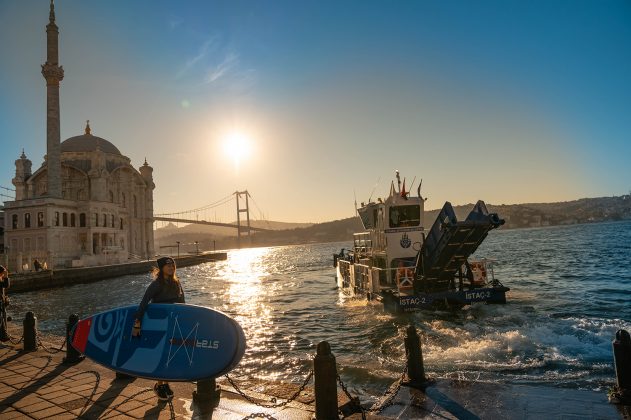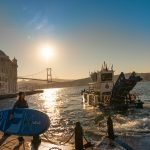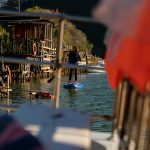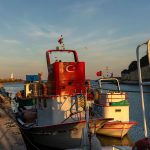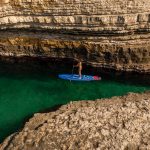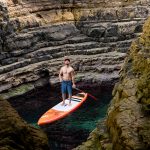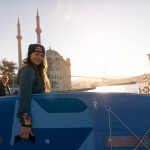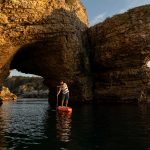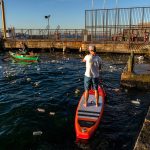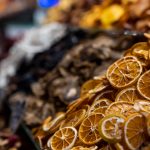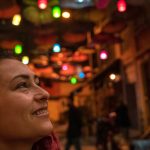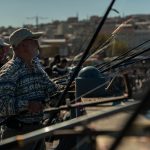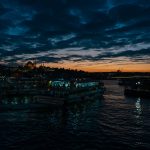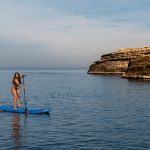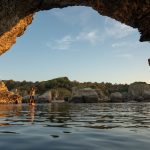TURKEY
Lena Erdil and Kai Steimer switch plans with the caprice of the Sinop wind on a trip that takes them out of Istanbul and onto the Black Sea…
With Lena Erdil
With its official count of 15 million inhabitants, Istanbul is a city connecting two continents physically and bridging East and West in many other ways. Its many mosques and minarets bloom majestically out of a sea of modern skyscrapers, while thrums of people from countless different backgrounds bustle through busy streets. The local ‘trash boy’ collects all the trash he can sell on out of bins on the street guarded by gangs of stray cats, while the modern women in her power suit and perfect blow-dry gets into her Range Rover and drives off to work. The retired high school teacher flicks his fishing lure from one of the many bridges crossing the Bosphorus, while the inescapable twenty-something hipsters fill the many third-wave coffee shops.
These images represent contrasts that are omnipresent. However, Istanbul seemingly not only spans east and west and many cultures, but often one feels that it has also managed to span across time; the old and new Turkey exist here together, but maybe not quite united. When talking about Turkey in Europe, most people immediately think about Erdogan and his authoritative rule, headlines of ‘coups’ , imprisoned journalists and bombings come to mind and mix with impressions we have from Ali, our local barber around the corner and late night kebab stops. Yet again others might remember their last Aegean holiday, far from the big city hustle. Kai Steimer, 10x German SUP champion decided to take a short trip to Turkey to visit German – Turkish Slalom Windsurfing Vice World Champion, Lena Erdil. Armed with two inflatable SUP’s, Kai and Lena are ready to challenge preconceptions and begin a six day trip to Istanbul. This city on the Bosphorus between the Black Sea, the Sea of Marmara and its countless channels should surely have a lot to offer. The plan is to discover Istanbul by SUP, and see if they can bring a twist to the usual tourist stops by adding some surf flair, but as so often happens, plans are set to diverge.
Ortaköy Mosque set right next to the Bosphorus and with the backdrop of the Fathi Sultan Mehmet bridge, which connects the Asian and European continents, is perhaps one of Istanbul’s most famous landmarks. Combing the ancient mosque and modern bridge with some SUP action is just right for the story this city wants to tell. When we arrive we are greeted by a boat collecting the trash out of the Bosphorus, amidst tons of floating plastic in just the spot we had planned to launch. Seeing a boat attempting to clean up the river makes us slightly happier, but unfortunately the boat seems very inefficient at its job. A diagonal ramp with a conveyor belt that provides little friction is lowered into the water and the bigger pieces of plastic just keep on rolling straight back down, making this an extremely lengthy process. Luckily the machine is aided by a volunteer fishermen with a simple net who seems way more effective than the boat at collecting the rubbish. While Kai and Lena pump up the boards and watch this scene unfold, other boats keep on passing as ferries are the Istanbulites preferred public transport and definitely the faster way across the Bosphorus, especially during rush hour. The water is extremely choppy and as Lena is still recovering from a foot injury (this was supposed to be her first time back on the board) it is decided that she is to stay on land in charge of taking photos. Kai jumps in amidst a group of Japanese tourists turning up to get the same shot minus him on the SUP. Normally SUP’ing or windsurfing in the busy parts of the Bosphorus is forbidden, but we are lucky and get the shots we wanted to get, and it must be time for a Turkish breakfast. Turkish breakfast can be anything from just bread and olives to the most elaborate kind of brunch you could think of. Turkish culture is a big believer in having a ‘rich table’ and that first, the eye needs to be satisfied, so while you sit and sip Turkish tea out of tiny glasses the table will be set with variations of different jams and honey, olives, cheeses, tomatoes and greens, before fried eggs with Turkish sausage and of course a variation of bread and ‘böreks’ a kind of Turkish pastry filled with cheese, herbs, potato or meat.
After two days of exploring on foot with deflated SUP’s, we decided to leave the city for a more authentic experience of what Turkey has to offer. With Google Maps as a tourist guide we head for the Black Sea. Satellite images of a rugged coastline reachable only by dirt roads seem appealing and very soon we’re out of signal on a dirt road discovering that the Citroen Berlingo is perhaps not as up for this adventure as its occupants. We cross paths with a local shepherd on his quad bike telling us that the road is blocked ahead and questioning our destination. ‘We are just looking for some beautiful bays in the area’ Lena explains in Turkish ‘can you recommend us something? Also, we are almost out of fuel, can we refuel somewhere?’ – ‘the closest petrol station is 50km away but I have some fuel in my village if you want. I am on my way to find my heard and there is this beautiful bay not far from here; follow me’. Whilst Lena is thrilled and convinced by this encounter, Kai is a bit hesitant about following a random shepard on a quad bike into a little mountain village into the opposite direction of where we were headed. But after a 10 minute drive through yet more winding dirt roads we’re in front of this man’s shed and he produces the promised fuel. Whilst refuelling, he asks if he can jump in the car so he can leave his bike at the village since he is going to have to walk back with his herd. Agreed; the journey continues with our extra passenger and he explains that after many years of working in a shop in Istanbul, he decided to move back to his village and a more simple life. He has 8 cows producing milk, cheese and yoghurt, whilst slowly growing his herd is how he gets by now. After a short drive down a forested path we find ourselves on a cliff top, the location is stunning and looks more than promising; the sea is calm and rock formations spike up from the ocean. Thanking Yasin the shepherd we say our goodbyes but not before getting yet more advice on where to eat and spend the night: we are to head towards Kerpe and find Captain Ali’s fish restaurant making sure to send his regards.
Climbing down the cliffs to the water with the SUP’s we decide the sea is calm enough to risk taking the camera and after three months off the water for Lena to get on a board again. The evening sun joins the magic display and we are soon paddling through caves in crystal clear water discovering little beaches between rocky ledges, a forested backdrop and not a single soul around. We later learn this spot has been called ‘the Phuket in our backyard’ by local travellers. With natural light fading quickly we decide it is best to head off to find Captain Ali, a place to stay and something to eat before the Berlingo’s lights will be all we have to find the way. Just as Yasin had promised, we find the Captain in a fish restaurant next to a small harbour. At last feasting on Black Sea fish, we’re pretty happy with how things have turned out so far, although we still have nowhere to stay. The Captain and his wife tell us that they had planned to build bungalows but have not yet quite got round to it, so we’re back into the Berlingo headed for Kerpe, at least with full bellies.
We find the only open hotel and turn out to be the only guests in the huge four story complex. There are rumours of surf in this place, but in the morning the sea is lake like and Kerpke really seems like a Ghost town, some kind of Hollywood film set, the buildings and hotels all seem strangely abandoned. Many of Turkey’s coastal towns only come alive in the summer months. Taking holidays abroad is not common in Turkey but most city dwellers have second homes at sea side towns and head out for a couple of months, leaving them abandoned for the rest of the year. September comes all of a sudden these holiday towns are abandoned, leaving only undernourished street dogs to patrol the streets.
Guided yet again by Google Earth we stumble on the ‘famous cliffs’ of Kerpe, so Lena heads out on her board while Kai flies the drone to get some aerial footage of this place. Around the first corner, Lena finds a little ledge and an entrance to what looks like an elaborate cave structure. Continuing with high excitement levels, she paddles back to tell Kai that he needs to join immediately so that they can explore the caves that seem accessible only by SUP and which on top of it are surrounded by crystal clear turquoise water! Arriving at the cave they hear some bizarre singing echoing from inside the cage.
Sounds that seem difficult to place, but it is clear they are not alone here. It turns out that these caves can also be reached by land and they are joined in the exploring act by a Korean family singing Korean songs to test the echo in the tunnel of the caves.
Before heading back to Istanbul we plan to stop in Agva, a town set between two rivers which offers exploration potential. Too lazy to deflate the boards we tie them to the roof – but without straps a little piece of old rope we find will have to make do and does. But shortly after leaving Kerpe we drive into what looks like an army roadblock. Kai is worried about the SUPs tied so shoddily, in Germany this would result in a fine for sure, but we’re in Turkey, more specifically, in the middle of the country side. Rolling down the car windows, the officer says nothing about the boards and simply asks for our IDs. One of them goes off to run them through the system while the other engages them in a friendly chat. “Oh you are surfers? Its’ great here for that…oh and where in Istanbul are you from? Ah me too, that’s where I last worked, it’s a great place…” The other officer comes back with the all clear and we even get a little travel advice about a new bridge not yet visible on the GPS. Random ID checks are quite common in Turkey and it is mandatory to carry ID, but usually officials are very friendly.
Arriving in Agva we quickly find the best launch spot. The river is lined with little wooden jetties, some with fishermen’s huts on top. It’s where the fishermen usually dock, but most of the boats seem to be at sea. Launching between the jetties and wooden huts Kai and Lena start paddling and fifteen minutes later reach the open sea. Next to a long walkway with a lighthouse at the end lies a beach serving up tiny breaking waves. Very small, but just strong enough to get a board planing and even sort of riding. Then comes the attempted party wave; Lena loses her balance and falls in fully clothed. Turns out Lena’s balance is not quite up to standards after her recent injury and she is rewarded with a cold paddle back up the river in the falling light.
Back on land and dry again they find a restaurant with a fire place to warm up and enjoy more home cooked black sea specialities. Kai is once more surprised by the hospitality of the people we’ve met on this trip. Lena explains that it is quite common place, in Turkish culture many people call each other brother, sister, uncle or even granddad without actually being related. This is probably rooted in the fact that before moving to big cities, many people are brought up in small villages where everyone knows each other, and even if their surroundings change they keep their small town attitude. And it seems that they embrace it anew when they move back home again, like Yasin the Shepherd, the Captain and his wife, or even the Jandarma officer.
The drive back to Istanbul airport takes us through lush green mountains and endless hazelnut fields giving us time to reflect on the trip. With an impulsive urge to leave the busy city life of Istanbul behind their city sup trip turned into a transformative Black Sea adventure. Abandoned villages, dirt roads, boulders and caves rising out of crystal clear waters. A cliffy forested coastline ready to be explored in almost total solitude, with Google Earth as your only guide.
While Istanbul is the industrial and financial centre of Turkey, it’s a place where extremely rich and very poor live people next to each other in a melting pot of cultures. When Lena asks what surprised Kai the most on this journey and if some of his preconceptions are changed re replies: ‘I was amazed by the hospitality of the people we met on the way, all of them enjoying giving without expecting anything in return, I haven’t experienced this kind of attitude in a very long time in Europe and really didn’t expect to find it here. In my mind Turkey was more of a ‘Muslim country’ more like Morocco, so I was surprised that none of the people we met seemed particularly religious. In some ways I felt like we went back in time, the way most the food we ate was local produce sourced right where we were, or how people burn coal or wood for heating their houses…I loved the nature and just how clean and clear the water was everywhere we went. Istanbul and its minarets, markets and the Bosphorus were like out of some kind of fairytale story. I feel that we have only just scratched the surface.’ SUP International

